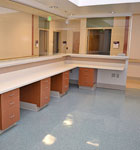
The project really predates anybody that’s around today, and it’s really been an evolution over a period of time. The mining of the property started way back in 1946—and the underground portion of it in 1954. It wasn’t until 1960 that enough space had been mined out in the underground. At that point my father, who was president and founder of the company, started looking with some of his business associates at potential uses of underground space. You know, you’ve got this big hole in the ground—what do you do with it?
I think that’s where a lot of the innovation took place, was back then. They went out and built the first 120,000-square-foot underground industrial building as a public warehouse and leased that space out to a public-warehousing company to use for storage. The success of that caused the local Kraft cheese plant to look at it and say, “Could we create some refrigerated space down underground?” By 1962, just two years later, they had built their first cold-storage building.
In 1980, we started our biggest single building. It was 320,000 square feet, and it was a distribution center. We had to, at that point, do some master planning of the mined out space to figure out where the streets and highways were going to be. At that point it really became a planned underground development instead of just a side project in a mining operation.
As the construction has progressed in the facility, we’ve certainly discovered some tricks of the trade. For the building walls, for example, we used to use traditional masonry block, but now we’ve gone to insulated blocks with shotcrete on both sides. It goes up very quickly, takes a lot less labor at a much reduced cost, and we end up with a fireproof wall that’s also insulated. We also suspended a lot of things from the rock ceiling with anchors. The sprinklers are suspended. The lighting is suspended. That’s certainly different.
Fortunately, we’ve got some contractors in this area that have developed expertise working underground. Dewitt & Associates, Inc. and Wirt Coproration are both local contractors we’ve worked with, and Stellar is a refrigeration, engineering, and design firm that’s done turnkey refrigeration systems for us. One of the other advantages we have is we can do our construction year-round. There’s a constant temperature and constant weather down there, which means we can do a lot of work in the winter time.
In addition to the temperature and security benefits the underground provides, we’ve also developed our facility to be green and sustainable. We’ve had difficulty getting LEED certification because we are so far outside the definitions that they have. But we do everything we can do to go in the direction that LEED certification would want us to go. We really take those concepts to heart and try to embody those in our development. For example, Kraft Foods has a corporate sustainability competition between their different properties. After a year or two, they decided they’re not going to let their underground distribution center compete anymore because they would just win every year. It was unfair to the above-ground facilities.
As we finish up the mining operation in the next few years, there’s the potential to finish up the developed area rather rapidly as clients come in and want the space. We actually have purchased another property on the other side of town, another 500-plus-acre property, and intend to go over there and start over again. ABQ



